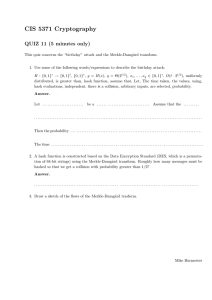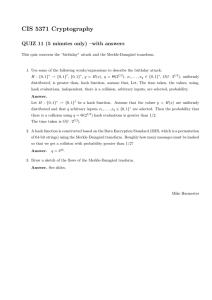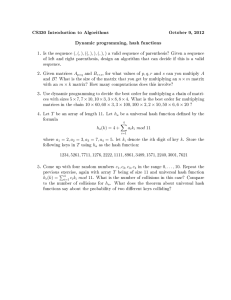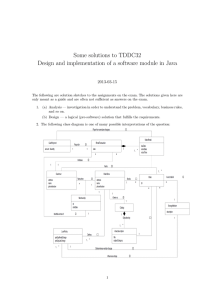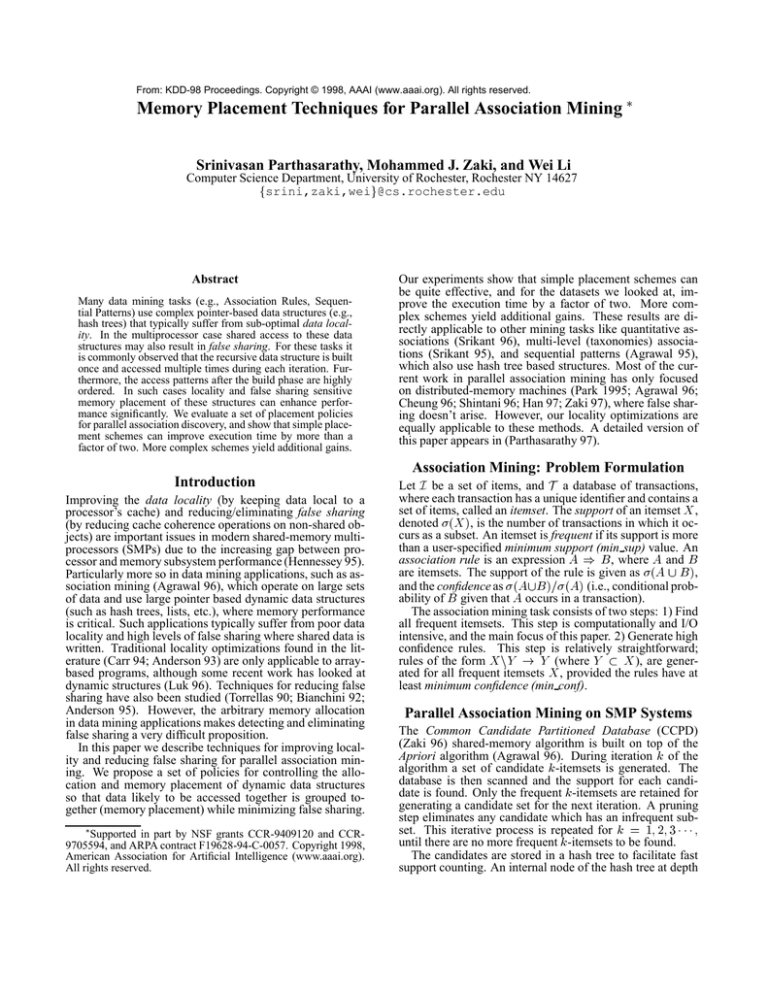
From: KDD-98 Proceedings. Copyright © 1998, AAAI (www.aaai.org). All rights reserved.
Memory Placement Techniques for Parallel Association Mining
Srinivasan Parthasarathy, Mohammed J. Zaki, and Wei Li
Computer Science Department, University of Rochester, Rochester NY 14627
fsrini,zaki,weig@cs.rochester.edu
Abstract
Many data mining tasks (e.g., Association Rules, Sequential Patterns) use complex pointer-based data structures (e.g.,
hash trees) that typically suffer from sub-optimal data locality. In the multiprocessor case shared access to these data
structures may also result in false sharing. For these tasks it
is commonly observed that the recursive data structure is built
once and accessed multiple times during each iteration. Furthermore, the access patterns after the build phase are highly
ordered. In such cases locality and false sharing sensitive
memory placement of these structures can enhance performance significantly. We evaluate a set of placement policies
for parallel association discovery, and show that simple placement schemes can improve execution time by more than a
factor of two. More complex schemes yield additional gains.
Our experiments show that simple placement schemes can
be quite effective, and for the datasets we looked at, improve the execution time by a factor of two. More complex schemes yield additional gains. These results are directly applicable to other mining tasks like quantitative associations (Srikant 96), multi-level (taxonomies) associations (Srikant 95), and sequential patterns (Agrawal 95),
which also use hash tree based structures. Most of the current work in parallel association mining has only focused
on distributed-memory machines (Park 1995; Agrawal 96;
Cheung 96; Shintani 96; Han 97; Zaki 97), where false sharing doesn’t arise. However, our locality optimizations are
equally applicable to these methods. A detailed version of
this paper appears in (Parthasarathy 97).
Association Mining: Problem Formulation
Introduction
Improving the data locality (by keeping data local to a
processor’s cache) and reducing/eliminating false sharing
(by reducing cache coherence operations on non-shared objects) are important issues in modern shared-memory multiprocessors (SMPs) due to the increasing gap between processor and memory subsystem performance (Hennessey 95).
Particularly more so in data mining applications, such as association mining (Agrawal 96), which operate on large sets
of data and use large pointer based dynamic data structures
(such as hash trees, lists, etc.), where memory performance
is critical. Such applications typically suffer from poor data
locality and high levels of false sharing where shared data is
written. Traditional locality optimizations found in the literature (Carr 94; Anderson 93) are only applicable to arraybased programs, although some recent work has looked at
dynamic structures (Luk 96). Techniques for reducing false
sharing have also been studied (Torrellas 90; Bianchini 92;
Anderson 95). However, the arbitrary memory allocation
in data mining applications makes detecting and eliminating
false sharing a very difficult proposition.
In this paper we describe techniques for improving locality and reducing false sharing for parallel association mining. We propose a set of policies for controlling the allocation and memory placement of dynamic data structures
so that data likely to be accessed together is grouped together (memory placement) while minimizing false sharing.
Supported in part by NSF grants CCR-9409120 and CCR9705594, and ARPA contract F19628-94-C-0057. Copyright 1998,
American Association for Artificial Intelligence (www.aaai.org).
All rights reserved.
Let I be a set of items, and T a database of transactions,
where each transaction has a unique identifier and contains a
set of items, called an itemset. The support of an itemset X ,
denoted (X ), is the number of transactions in which it occurs as a subset. An itemset is frequent if its support is more
than a user-specified minimum support (min sup) value. An
association rule is an expression A ) B , where A and B
are itemsets. The support of the rule is given as (A [ B ),
and the confidence as (A[B )= (A) (i.e., conditional probability of B given that A occurs in a transaction).
The association mining task consists of two steps: 1) Find
all frequent itemsets. This step is computationally and I/O
intensive, and the main focus of this paper. 2) Generate high
confidence rules. This step is relatively straightforward;
rules of the form X nY ! Y (where Y X ), are generated for all frequent itemsets X , provided the rules have at
least minimum confidence (min conf).
Parallel Association Mining on SMP Systems
The Common Candidate Partitioned Database (CCPD)
(Zaki 96) shared-memory algorithm is built on top of the
Apriori algorithm (Agrawal 96). During iteration k of the
algorithm a set of candidate k -itemsets is generated. The
database is then scanned and the support for each candidate is found. Only the frequent k -itemsets are retained for
generating a candidate set for the next iteration. A pruning
step eliminates any candidate which has an infrequent subset. This iterative process is repeated for k = 1; 2; 3 ;
until there are no more frequent k -itemsets to be found.
The candidates are stored in a hash tree to facilitate fast
support counting. An internal node of the hash tree at depth
Candidate Hash Tree (C 3)
Hash Function: h(B)=h(D)=0 ; h(A)=h(C)=h(E)=1
B,D
DEPTH 0
0
HASH TREE NODE (HTN): INTERNAL
HTN_Pointer_Array
Hash_Table:
Itemset_List = NULL
A,C,E
1
HTN
DEPTH 1
B,D
0
DEPTH 2
B,D
0
LEAVES
A,C,E
B,D
0
1
HTN
A,C,E
1
HASH TREE NODE (HTN): LEAF
A,C,E
1
B,D
0
A,C,E
1
B,D
0
BDE
BCD
BCE
ABD
A,C,E
1
ABC
ABE
ADE
CDE
B,D
A,C,E
0
1
ACD
ACE
ListNode (LN)
Hash_Table = NULL
Itemset_List:
3-Itemset
A
A
B
B
A
D
C
E
E
Figure 1: a) Candidate Hash Tree; b) Structure of Internal and Leaf Nodes
d contains a hash table whose cells point to nodes at depth
d + 1. All the itemsets are stored in the leaves in a sorted
linked-list. The maximum depth of the tree in iteration k
is k . Figure 1a shows a hash tree containing candidate 3-
itemsets, and Figure 1b shows the structure of the internal
and leaf nodes in more detail. The different components of
the hash tree are as follows: hash tree node (HTN), hash table (HTNP), itemset list header (ILH), list node (LN), and
the itemsets (ISET). An internal node has a hash table pointing to nodes at the next level, and an empty itemset list,
while a leaf node has a list of itemsets. To count the support of candidate k -itemsets, for each transaction T in the
database, we form all k -subsets of T in lexicographical order. For each subset we then traverse the hash tree, look for
a matching candidate, and update its count.
CCPD keeps a common candidate hash tree, but logically
splits the database among the processors. The new candidates are generated and inserted into the hash tree in parallel. After candidate generation each processor scans its
local database portion and counts the itemset support in parallel. Each itemset has a single counter protected by a lock
to guarantee mutual exclusion when multiple processors try
to increment it at the same time. Finally, the master process
selects the frequent itemsets. The support counting step typically accounts for 80% of the total computation time (Zaki
96). It can be observed that once the tree is built it is accessed multiple times during each iteration (once per transaction). Our locality enhancement techniques focus on improving the performance of these accesses.
Memory Placement Policies
In this section we describe a set of custom memory placement policies for improving the locality and reducing false
sharing for parallel association mining. To support the different policy features we implemented a custom memory
placement and allocation library. In contrast to the standard
Unix malloc library, our library allows greater flexibility in
controlling memory placement. At the same time it offers
a faster memory freeing option, and efficient reuse of preallocated memory. Furthermore it does not pollute the cache
with boundary tag information.
Improving Reference Locality
It was mentioned in the introduction that it is extremely
important to reduce the memory latency for data intensive
applications like association mining by effective use of the
memory hierarchy. In this section we consider several mem-
ory placement policies for the candidate hash tree. All the
locality driven placement strategies are directed in the way
in which the hash tree and its building blocks (hash tree
nodes, hash table, itemset list, list nodes, and the itemsets)
are traversed with respect to each other. The specific policies
we looked at are described below.
The Common Candidate Partitioned Database (CCPD)
scheme is the original program that includes calls to the standard Unix memory allocation library on the target platform.
In the Simple Placement Policy (SPP) all the different
hash tree building blocks are allocated memory from a single region. This scheme does not rely on any special placement of the blocks based on traversal order. Placement is
implicit in the order of hash tree creation. Data structures
calling consecutive calls to the memory allocation routine
are adjacent in memory. The runtime overhead involved for
this policy is minimal. There are three possible variations
of the simple policy depending on where the data structures
reside: 1) Common Region: all data structures are allocated
from a single global region, 2) Individual Regions: each data
structure is allocated memory from a separate region specific
to that structure, and 3) Grouped Regions: data structures
are grouped together using program semantics and allocated
memory from the same region. The SPP scheme in this paper uses the Common Region approach.
The Localized Placement Policy (LPP) groups related
data structures together using local access information
present in a single subroutine. In this policy we utilize a
“reservation” mechanism to ensure that a list node (LN) with
its associated itemset (ISET) in the leaves of the final hash
tree are together whenever possible, and that the hash tree
node (HTN) and the itemset list header (ILH) are together.
The rationale behind this placement is the way the hash tree
is traversed in the support counting phase. An access to a
list node is always followed by an access to its itemset, and
an access to a leaf hash tree node is followed by an access to
its itemset list header. Thus contiguous memory placement
of the different components is likely to ensure that when one
component is brought into the cache, the subsequent one is
also brought in, improving the cache hit rate and locality.
The Global Placement Policy (GPP) utilizes the knowledge of the entire hash tree traversal order to place the hash
tree building blocks in memory, so that the next structure to
be accessed lies in the same cache line in most cases. The
construction of the hash tree proceeds in a manner similar to
SPP. We then remap the entire tree according the tree access
pattern in the support counting phase. In our case the hash
tree is remapped in a depth-first order, which closely approx-
HASH TREE
HTN#1
Standard Malloc
00 HTNP#2
11
111
000
00
11
000HTN#1 11
111
00
000
111
00
11
00000000
11111111
000
111
HTN#3 11
HTNP#4
00
00000000
11111111
000
111
11
00
00000000
11111111
000
111
00000000
11111111
HTN#5
LN#6
00000000
11111111
00000000
11111111
000
111
ISET#7
LN#8
00000000
11111111
000
111
00000000
11111111
111
000
00000
11111
00000000
11111111
ISET#9
HTN#10
00000
11111
00000000
11111111
00000
11111
00000000
0 HTNP#1111111111
1
00000
11111
HTN#12
00000000
11111111
0
1
00000
11111
00000000
11111111
0
1
00000
11111
0 ISET#14
1
LN#131
00000
11111
0
00000
11111
0
1
Hash Table
HTNP#2
HTN#10
HTN#3
Hash Table
Hash Table
Custom Malloc
HTN#12
Itemset List
HTN#5
1111111111111
0000000000000
0000000000000
1111111111111
0000000000000
1111111111111
0000000000000
1111111111111
0000000000000
1111111111111
0000000000000
1111111111111
Itemset List
LN#6
LN#13
HTN#1
HTNP#2
HTN#3
HTNP#4
HTN#5
LN#6
ISET#7
ISET#9
LN#8
HTN#10
HTNP#11
HTN#12
0000000000000
1111111111111
ISET#14
LN#13
0000000000000
1111111111111
HTNP#4
HTNP#11
LN#8
Remapping in Depth-First Order
C
E
D
E
ISET#9
D
B
ISET#7
B
C
ISET#14
A
HTN#1
HTNP#2
HTN#10
HTNP#11
HTN#12 LN#13
ISET#14 HTN#3
HTNP#4
ISET#7
HTN#5 LN#6
0000000000000
1111111111111
ISET#9
LN#8
0000000000000
1111111111111
1111111111111
0000000000000
0000000000000
1111111111111
0000000000000
1111111111111
0000000000000
1111111111111
0000000000000
1111111111111
0000000000000
1111111111111
Figure 2: Improving Reference Locality via Custom Memory Placement of Hash Tree
imates the hash tree traversal. The remapped tree is allocated
from a separate region. Remapping costs are comparatively
low and this policy also benefits by delete aggregation and
the lower maintenance costs of our custom library.
Custom Placement Example A graphical illustration of
the CCPD, Simple Placement Policy, and the Global Placement Policy appears in Figure 2. The figure shows an example hash tree that has three internal nodes (HTN#1, HTN#10,
HTN#3), and two leaf nodes (HTN#12, HTN#5). The numbers after each structure show the creation order when the
hash tree is built. For example, the very first memory allocation is for hash tree node HTN#1, followed by the hash table
HTNP#2, and so on. The very last memory allocation is for
ISET#14. Each internal node points to a hash table, while
the leaf nodes have a linked list of candidate itemsets.
The original CCPD code uses the standard malloc library.
The different components are allocated memory in the order of creation and may come from different locations in
the heap. The box on top right labeled Standard Malloc
corresponds to this case. The box labeled Custom Malloc corresponds to the SPP policy. No access information
is used, and the allocation order of the components is the
same as in the CCPD case. However, the custom malloc
library ensures that all allocations are contiguous in memory, and can therefore greatly assist cache locality. The last
box labeled Remapping in Depth-First Order corresponds to
the GPP policy. In the support counting phase each subset
of a transaction is generated in lexicographic order, and a
tree traversal is made. This order roughly corresponds to
a depth first search. We use this global access information
to remap the different structures so that those most likely
to be accessed one after the other are also contiguous in
memory. The order of the components in memory is now
HTN#1, HTNP#2, HTN#10, HTNP#11, etc., corresponding
to a depth-first traversal of the hash tree.
Reducing False Sharing
A problem unique to shared-memory systems is false sharing, which occurs when two different shared variables are
located in the same cache block, causing the block to be
exchanged between the processors even though the processors are accessing different variables. For example, the support counting phase suffers from false sharing when updating the itemset support counters. A processor has to acquire
the lock, update the counter and release the lock. During
this time, any other processor that had cached the particular
block on which the lock was placed gets its data invalidated.
Since 80% of the time is spent in the support counting step it
is extremely important to reduce or eliminate the amount of
false sharing. Also, one has to be careful not to destroy locality while improving the false sharing. Several techniques
for alleviating this problem are described next.
One solution is Padding and Aligning, by placing unrelated read-write data on separate cache lines. For example,
we can align each itemset lock to a separate cache lines and
pad out the rest of the line. Unfortunately this is not a very
good idea for association mining because of the large number of candidate itemsets involved in some of the early iterations (around 0.5 million itemsets). While padding eliminates false sharing, it results in unacceptable memory space
overhead and more importantly, a significant loss in locality.
In Segregate Read-Only Data, instead of padding we separate out the locks and counters (read-write data) from the
itemset (read-only data). All the read-only data comes from
a separate region and locks and counters come from a separate region. This ensures that read-only data is never falsely
shared. Although this scheme does not eliminate false sharing completely, it does eliminate unnecessary invalidations
of the read-only data, at the cost of some loss in locality and
an additional overhead due to the extra placement cost. On
top of each of the locality enhancing schemes, we added a
separate read-write region for locks and counters. The three
resulting strategies are, L-SPP, L-LPP, and L-GPP.
The Privatize (and Reduce) scheme involves making a
private copy of the data that will be used locally, so that
operations on that data do not cause false sharing. For association mining, we can utilize that fact that the counter
increment is a simple addition operation and one that is associative and commutative. This property allows us to keep a
local array of counters per processor. Each processor can increment the support of an itemset in its local array during the
support counting phase. This is followed by a global sumreduction. This scheme eliminates false sharing completely,
with acceptable levels of memory wastage. This scheme also
eliminates the need for lock synchronization among processors, but it has to pay the cost of the extra reduction step.
We combine this scheme with the global placement policy
to obtain a scheme which has good locality and eliminates
false sharing completely. We call this scheme Local Counter
Array-Global Placement Policy (LCA-GPP).
Experimental Evaluation
All the experiments were performed on a 12-node SGI Challenge SMP machine with 256MB main-memory, running
IRIX 5.3. Each node is a 100MHz MIPS processor with
a 16KB primary cache and 1MB secondary cache. The
databases are stored on a non-local 2GB disk. We used different benchmark databases generated using the procedure
described in (Agrawal 96). Table 1 shows the databases used
and the total execution times of CCPD on 0.1% (0.5%) minimum support. For example, T5.I2.D100K corresponds to
a database with average transaction size of 5, average maximal potential large itemset size of 2, and 100,000 transactions. We set the number of maximal potentially large itemsets jLj = 2000, and the number of items N = 1000.
Database
( 100K)
T5.I2.D1
T10.I4.D1
T20.I6.D1
T10.I6.D4
T10.I6.D8
T10.I6.D16
T10.I6.D32
Size
(MB)
3
4
8
17
35
70
137
CCPD 0.1%(0.5%) in Seconds
P=1
P=4
P=8
44(13)
28(9)
27(8)
133(66)
70(32)
57(24)
3027(325)
1781(126)
1397(81)
895(226)
398(81)
289(56)
2611(463)
1383(159)
999(95)
2831(884)
1233(280)
793(161)
6085(2144) 2591(815) 1677(461)
Table 1: Total Execution Times for CCPD
Figure 3 shows the sequential (P=1) and parallel (P=4,8)
performance of the different placement policies on the different databases. All times are normalized with respect to
the CCPD time for each database. In the graphs, the strategies have roughly been arranged in increasing order of complexity from left to right, i.e., CCPD is the simplest, while
LCA-GPP is the most complex. The databases have also
been arranged in increasing order of size from left to right.
Uniprocessor Performance In the sequential run we only
compare the three locality enhancing strategies on different
databases, since there can be no false sharing in a uniprocessor setting. The simple placement (SPP) strategy does
extremely well, with 35-55% improvement over the base algorithm. This is due to the fact that SPP is the least complex
in terms of runtime overhead. Furthermore, one a single processor, the creation order of the hash tree in the candidate
generation phase, is approximately the same as the access
order in the support counting phase, i.e., in lexicographic
order. The global placement strategy (GPP) involves the
overhead of remapping the entire hash tree (less than 2% of
the running time). On smaller datasets we observe that the
gains in locality are not sufficient in overcoming this overhead. However GPP performs the best on larger datasets.
Multiprocessor Performance For the multiprocessor
case both the locality and false sharing sensitive placement
schemes are important. We observe that as the databases become larger, the more complex strategies perform the best.
This is due to the fact that larger databases spend more time
in the support counting phase, and consequently there are
more locality gains, which are enough to offset the added
overhead. We also observed that on lower values of support (0.1% vs 0.5% in Figure 3), our optimizations perform better since the ratio of memory placement overhead
to the total execution time reduces. Further, on lower support the hash tree tends to be larger, and has greater potential to benefit from appropriate placement. For example, on
T20.I6.D100K the relative benefits on 0.1% support are 30%
more than on 0.5% support. Also on 0.5% GPP performs
better than SPP only on the largest dataset, whereas on 0.1%
GPP performs better for all except the 2 smallest datasets.
We will now discuss some policy specific trends. The base
CCPD algorithm suffers from a poor reference locality and
high amount of false sharing, due to the dynamic nature of
memory allocations and due to the shared accesses to the
itemsets, locks and counters, respectively. The SPP policy,
which places all the hash tree components contiguously, performs extremely well. This is not surprising since it imposes
the smallest overhead, and the dynamic creation order to an
extent matches the hash tree traversal order in the support
counting phase. The custom memory allocation library in
SPP also avoids polluting the cache with boundary tag information. We thus obtain a gain of 35-63% by using the
simple scheme alone. For L-SPP, with a separate lock and
counter region, we obtain slightly better results than SPP. As
with all lock-region based schemes, L-SPP loses on locality,
but with increasing data sets, the benefits of reducing false
sharing outweigh that overhead. The localized placement
of L-LPP doesn’t help much. It is generally very close to
L-SPP. From a pure locality viewpoint, the GPP policy performs the best with increasing data size. It uses the hash tree
traversal order to re-arrange the hash tree to maximize locality, resulting in significant performance gains. L-GPP outperforms GPP only for the biggest datasets. The best overall
scheme is LCA-GPP, with upto a 20% gain over SPP, since it
has a local counter array per processor that eliminates false
sharing and lock synchronization completely, but at the same
time it retains good locality.
Conclusions
In this paper, we proposed a set of policies for controlling
the allocation and memory placement of dynamic data structures that arise in parallel association mining, to achieve
the conflicting goals of maximizing locality and minimizing false sharing. Our experiments show that simple placement schemes can be quite effective, improving the execution time by a factor of two (upto 60% better than the base
case). With larger datasets and at lower values of support,
the more complex placement schemes yielded additional improvements (upto 20% better than simple scheme).
References
Agrawal, R., and Shafer, J. 1996. Parallel mining of association
rules. IEEE Trans. on Knowledge and Data Engg. 8(6):962–969.
Agrawal, R., and Srikant, R. 1995. Mining sequential patterns.
In 11th Intl. Conf. on Data Engg.
Agrawal, R.; Mannila, H.; Srikant, R.; Toivonen, H.; and
Verkamo, A. I. 1996. Fast discovery of association rules. In
Fayyad, U., eds., Advances in KDD, 307–328. AAAI Press.
Anderson, J. M., and Lam, M. 1993. Global optimizations for
parallelism and locality on scalable parallel machines. ACM Conf.
Programming Language Design and Implementation.
#proc = 1 (0.5% support)
#proc = 1 (0.1% support)
CCPD
CCPD
LPP
GPP
0.80
0.60
0.40
0.20
SPP
Normalized Execution Time
Normalized Execution Time
SPP
1.00
0.00
1.00
LPP
GPP
0.80
0.60
0.40
0.20
0.00
T5.I2.D100K
T10.I4.D100K
T20.I6.D100K
T10.I6.D400K
T10.I6.D800K
T10.I6.D1600K
T5.I2.D100K
T10.I4.D100K
T20.I6.D100K
Databases
T10.I6.D400K
T10.I6.D800K
T10.I6.D1600K
Databases
#proc = 4 (0.5% support)
#proc = 4 (0.1% support)
CCPD
CCPD
L-SPP
L-LPP
GPP
0.80
L-GPP
LCA-GPP
0.60
0.40
0.20
0.00
T5.I2.D100K
T10.I4.D100K
T20.I6.D100K
T10.I6.D400K
SPP
Normalized Execution Time
Normalized Execution Time
SPP
1.00
1.00
L-LPP
GPP
0.80
L-GPP
LCA-GPP
0.60
0.40
0.20
0.00
T10.I6.D800K T10.I6.D1600K T10.I6.D3200K
L-SPP
T5.I2.D100K
T10.I4.D100K
Databases
T20.I6.D100K
T10.I6.D400K
T10.I6.D800K T10.I6.D1600K T10.I6.D3200K
Databases
#proc = 8 (0.5% support)
#proc = 8 (0.1% support)
CCPD
CCPD
L-SPP
L-LPP
GPP
0.80
L-GPP
LCA-GPP
0.60
0.40
0.20
0.00
T5.I2.D100K
T10.I4.D100K
T20.I6.D100K
T10.I6.D400K
T10.I6.D800K T10.I6.D1600K T10.I6.D3200K
Databases
SPP
Normalized Execution Time
Normalized Execution Time
SPP
1.00
1.00
L-SPP
L-LPP
GPP
0.80
L-GPP
LCA-GPP
0.60
0.40
0.20
0.00
T5.I2.D100K
T10.I4.D100K
T20.I6.D100K
T10.I6.D400K
T10.I6.D800K T10.I6.D1600K T10.I6.D3200K
Databases
Figure 3: Memory Placement Policies: 1, 4, and 8 Processors
Anderson, J. M.; Amarsinghe, S. P.; and Lam, M. 1995. Data and
computation transformations for multiprocessors. ACM Symp.
Principles and Practice of Parallel Programming.
Bianchini, R., and LeBlanc, T. J. 1992. Software caching on
cache-coherent multiprocessors. 4th Symp. Par. Dist. Processing.
Carr, S.; McKinley, K. S.; and Tseng, C.-W. 1994. Compiler optimizations for improving data locality. 6th ACM ASPLOS Conf.
Cheung, D.; Ng, V.; Fu, A.; and Fu, Y. 1996. Efficient mining
of association rules in distributed databases. In IEEE Trans. on
Knowledge and Data Engg., 8(6):911–922.
Han, E.-H.; Karypis, G.; and Kumar, V. 1997. Scalable parallel
data mining for association rules. In ACM SIGMOD Conference.
Hennessey, J., and Patterson, D. 1995. Computer Architecture :
A Quantitative Approach. Morgan-Kaufmann Pub.
Luk, C.-K., and Mowry, T. C. 1996. Compiler-based prefetching
for recursive data structures. 6th ACM ASPLOS Conference.
Park, J. S.; Chen, M.; and Yu, P. S. 1995. Efficient parallel data
mining for association rules. In ACM Conf. Info. Know. Mgmt.
Parthasarathy, S.; Zaki, M. J.; and Li, W. 1997. Custom memory
placement for parallel data mining. U. of Rochester, TR 653.
Shintani, T., and Kitsuregawa, M. 1996. Hash based parallel
algorithms for mining association rules. 4th Intl. Conf. Parallel
and Distributed Info. Systems.
Srikant, R., and Agrawal, R. 1995. Mining generalized association rules. In 21st VLDB Conference.
Srikant, R., and Agrawal, R. 1996. Mining quantitative association rules in large relational tables. In ACM SIGMOD Conference.
Torrellas, J.; Lam, M. S.; and Hennessy, J. L. 1990. Shared data
placement optimizations to reduce multiprocessor cache miss
rates. Intl. Conf. Parallel Processing II:266–270.
Zaki, M. J.; Ogihara, M.; Parthasarathy, S.; and Li, W. 1996. Parallel data mining for association rules on shared-memory multiprocessors. In Supercomputing’96.
Zaki, M. J.; Parthasarathy, S.; Ogihara, M.; and Li, W. 1997. New
parallel algorithms for fast discovery of association rules. J. Data
Mining and Knowledge Discovery 1(4):343-373.


